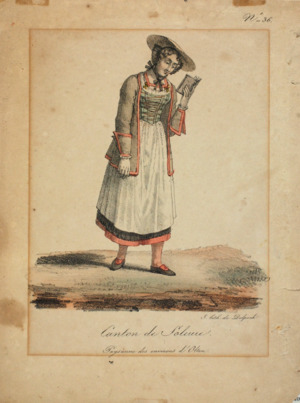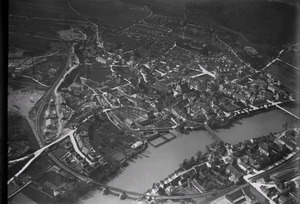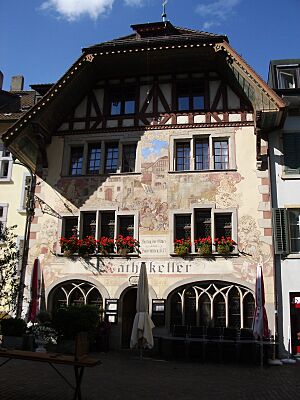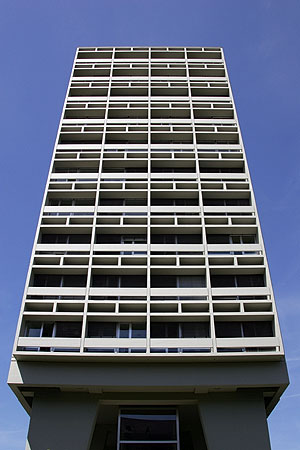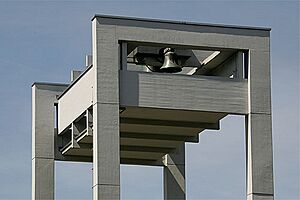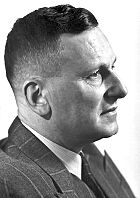Olten facts for kids
Quick facts for kids
Olten
|
||
|---|---|---|
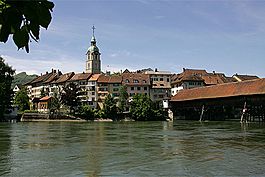
Old town with covered bridge
|
||
|
||
| Country | Switzerland | |
| Canton | Solothurn | |
| District | Olten | |
| Area | ||
| • Total | 11.49 km2 (4.44 sq mi) | |
| Elevation | 396 m (1,299 ft) | |
| Population
(Dec 2020 )
|
||
| • Total | 18,496 | |
| • Density | 1,609.7/km2 (4,169.2/sq mi) | |
| Postal code |
4600
|
|
| Surrounded by | Aarburg (AG), Boningen, Dulliken, Kappel, Rothrist (AG), Starrkirch-Wil, Trimbach, Wangen bei Olten, Winznau | |
| Twin towns | Altenburg (Germany) | |
Olten is a town in the canton of Solothurn in Switzerland. It is the capital of the Olten district.
Olten grew into a town during the Middle Ages. It was built where a bridge crossed the Aare river. After a quiet period, it grew very fast in the 1800s. This was because of the railway.
Today, Olten's train station is a major railway hub in Switzerland. It connects lines to big cities like Zürich, Basel, Bern, and Lucerne. You can reach these cities in about 30 minutes by train. The town also has a large depot for the Swiss Federal Railways.
Contents
History of Olten
People lived near Olten a very long time ago. Tools from about 16,000 to 14,000 years ago have been found. There are also finds from the Stone Age.
During the Roman era, there was a small Roman settlement here. It was likely important because of the bridge over the Aare river. This Roman settlement was probably destroyed in the late 200s AD.
Later, a fort was built at the bridge. This fort was replaced by a larger castle. These castles protected river crossings.
Olten in the Middle Ages
The medieval town of Olten was built on the old Roman castle's foundations. It was first mentioned in the year 1201. The name Oltun might mean "river-fort."
In the 1200s, the counts of Frohburg owned Olten. It then passed to the Kyburg family in 1377. In 1384, the Habsburg family took control.
Basel took over Olten in 1407. They invested in the town. However, fires in 1411 and 1422 destroyed much of it. Basel then sold Olten to Solothurn in 1426.
For a long time, Olten was a small town. It had a fortified bridge and some services like blacksmiths. By 1600, only about 500 people lived there.
Olten's Growth and Challenges
In 1653, Olten lost its city rights. This was a punishment for supporting rebels in the Swiss Peasant War. Because of this, Olten developed a tradition of resisting authority.
The town welcomed French troops in the 1798 invasion. In 1814, Solothurn stopped another rebellion by Olten citizens.
Olten's population reached 1,000 people in the late 1700s. It grew much faster after the railway arrived in 1856. The town became an important industrial and transport center. By 1900, about 7,000 people lived there.
Olten became a second major city in the canton by the 1880s. It gained important buildings like the cantonal hospital (1880) and a business school (1912). The population tripled again in the 1900s. It reached 21,000 in 1970, but has slightly decreased since then.
Geography of Olten
Olten covers an area of about 11.49 square kilometers. About 12.7% of this land is used for farming. Forests cover 41.9% of the area.
Buildings and roads make up 40.5% of the land. Rivers and lakes cover 4.6%. A small part, 0.5%, is unproductive land.
The old part of Olten is in a bend of the Aare river. It is located between the Aare and Dünnern rivers. In the 1800s, new homes were built in the valley. These areas are between the Jura Mountains to the north and other mountains to the south.
Coat of Arms
The coat of arms of Olten shows three green fir trees. They stand on a green hill with three bumps. The tree trunks are red.
People of Olten (Demographics)
Olten has a population of about 18,863 people. About 27.3% of the people living in Olten are foreign nationals. Over the last ten years, the population has grown slightly.
Most people in Olten speak German. About 82.7% of the population speaks German. Italian is the second most common language, spoken by 5.0%. Albanian is third, spoken by 2.1%.
Many people living in Olten were born there. About 27.4% of the population in 2000 were born in Olten. Another 27.4% were born elsewhere in Switzerland. About 23.3% were born outside of Switzerland.
The population of Olten has changed over time. It grew a lot after the railway arrived. It reached its highest population in 1970. Since then, it has slightly decreased.
Important Heritage Sites
Olten has several important historical sites. These are recognized as Swiss heritage sites of national significance.
These sites include:
- The Old City, which has Roman, medieval, and early modern parts.
- The Train Station.
- The prehistoric and Roman hilltop settlement of Dickenbännli.
- The covered wooden bridge over the Aare river.
- The Naturmuseum (Nature Museum).
The entire town of Olten is also part of the Inventory of Swiss Heritage Sites.
Culture in Olten
Every year on August 1st, Olten hosts a big firework show. The fireworks are launched from boats on the river. The town is also famous for its wooden footbridge. This bridge is one of Olten's landmarks.
The Gruppe Olten (Olten Group) was founded in Olten's railway station restaurant. This was a group of famous writers, including Max Frisch and Friedrich Dürrenmatt. The Swiss Alpine Club was also founded here in 1863.
Economy of Olten
Olten is located where Switzerland's most important railway lines cross. Because of this, it has been known as a railway town for over 150 years. The Swiss Federal Railways has a main maintenance facility here. It was set up in 1855. The main office of SBB Cargo International is also in Olten.
Swiss Prime Site, a major real estate company in Switzerland, has its main office in Olten. The Walter Verlag publishing house was founded here in 1916. Its old building is now used by the Alternative Bank Schweiz (ABS).
In 2010, Olten had an unemployment rate of 4.4%. Many people work in the service industry. This includes jobs in sales, transport, hotels, and healthcare. Olten is a place where many people come to work. About 2.8 workers enter the town for every one who leaves.
Religion in Olten
According to the 2000 census, many people in Olten are Roman Catholic. About 40.6% of the population belongs to this church. Another 25.4% belong to the Swiss Reformed Church.
Some people belong to other Christian churches. About 8.13% of the population is Islamic. Many people in Olten do not belong to any church.
Churches in Olten
- Saint Martin's Church, Catholic (on the left side of the river)
- Old Saint Martin (Stadtkirche), Christ Catholic (on the left side of the river)
- Saint Paul, Protestant (on the left side of the river)
- Saint Mary (St. Marien) (on the right side of the river)
- Friedenskirche, Evangelic Protestant Reformist (on the right side of the river)
Education in Olten
Many people in Olten have completed higher education. About 36.4% have finished upper secondary education. About 13.5% have completed university or a polytechnic college.
The education system in Solothurn canton starts with two years of non-obligatory Kindergarten. After that, students attend six years of primary school. Then, there are three years of obligatory lower secondary school. This is followed by optional advanced schools.
The grammar school "Kantonsschule" or "Kanti" is on a hill near the train station. It has great views of the town. This school opened in 1974. It is home to about 1,000 students aged 12–18. Most students are preparing for the Swiss high school certificate. This certificate allows them to enter most Swiss universities.
The Fachhochschule Nordwestschweiz (polytechnic college) also has a campus in Olten. Olten has two libraries. These libraries offer many books and other media.
Sports in Olten
EHC Olten is a hockey team that plays in the Swiss League. They play their home games in the 6,500-seat Kleinholz Arena. The arena is often full for their games.
SC Altstadt Olten is another ice hockey team. They play in the Second Regio League. This is the fifth level of the Swiss ice hockey league system. This team also plays its home games in the Kleinholz Arena.
Notable people from Olten
- Martin Disteli (1802–1844) – a Swiss painter known for caricatures.
- Bernhard Hammer (1822–1907) – a Swiss politician who was President of the Confederation.
- Werner Munzinger (1832–1875) – a Swiss explorer of the Horn of Africa.
- Paul Hermann Müller (1899–1965) – a Swiss chemist who won the 1948 Nobel prize in Physiology or Medicine.
- Bruno Heim (1911–2003) – the Vatican's first Apostolic Nuncio to Britain.
- Lilian Uchtenhagen (1928–2016) – a politician and economist.
- Pedro Lenz (born 1965) – a Swiss writer.
- Ramon Vega (born 1971) – a retired footballer.
- Min Li Marti (born 1974) – a politician, publisher, and historian.
- Gökhan Inler (born 1984) – a Swiss professional footballer.
- Denis Malgin (born 1997) – a Swiss professional ice hockey player.
See also
 In Spanish: Olten para niños
In Spanish: Olten para niños





